![]()
![]()
![]()
Use LEFT and RIGHT arrow keys to navigate between flashcards;
Use UP and DOWN arrow keys to flip the card;
H to show hint;
A reads text to speech;
79 Cards in this Set
- Front
- Back
|
What is the deposition of cholesterol-rich material in a tissue called? |
Xanthomata |
|
|
What is tendon xanthomata in CV examination indicative of? |
Hyperlipidaemia |
|
|
Significance of pale palmar creases in CV exam |
Anaemia |
|
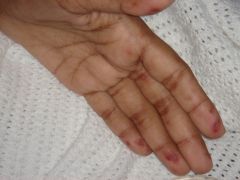
What are those? |
Osler's nodes or Janeway lesions |
|
|
What are Osler's nodes indicative of? |
Endocarditis |
|
|
Difference between Janeway lesions and Osler's nodes? |
Osler's nodes are tender |
|
|
Significance of Janeway lesions? |
Septic emboli in endocarditis |
|
|
Significance of clubbing in CV (2 causes) |
Cyanotic congenital heart disease Subacute endocarditis |
|
|
Significance of splinter haemorrhages in CV (3 causes) |
Trauma Endocarditis Vasculitis |
|
|
Three possible signs of endocarditis in the hand |
Janeway lesions or Osler's nodes Clubbing Splinter haemorrhages |
|
|
Significance of a regularly irregular pulse in CV (4 causes) |
Sinus arrhythmia Pulsus paradoxus Ectopic beats Second degree heart block |
|
|
Significance of an irregularly irregular pulse in CV |
AF |
|
|
Name 9 signs to elicit in the hand in CV |
Temperature Capillary refill time Colour (cyan) Tendon xanthomata Pale palmar creases Osler nodes Janeway lesions Clubbing Splinter haemorrhages |
|
|
Significance of radioradial delay |
Pre-left-subclavian aortic coarctation |
|
|
Significance of radiofemoral delay (3 causes) |
Post-left-subclavian aortic coarctation Aortic dissection Subclavian stenosis |
|
|
Significance of collapsing pulse |
Aortic regurgitation |
|
|
Significance of a wide pulse pressure |
Aortic regurgitation |
|
|
Significance of narrow pulse pressure |
Aortic stenosis |
|
|
What would you observe in the wrist during CV |
Radial pulse (rhythm, volume) Collapsing pulse Radioradial delay Radiofemoral delay
|
|

What are those? |
Xanthelasma (fatty deposits) |
|
|
Signs to elicit in the eye for CV exam (4) |
Corneal arcus Conjunctival pallor Petechial haemorrhages Xanthelasma |
|
|
Significance of corneal arcus in CV |
Normal in babies and elderies Hyperlipidaemia |
|
|
Significance of conjunctival pallor |
Severe anaemia |
|
|
Significance of petechial haemorrhages |
Benign Endocarditis Vasculitis |
|
|
Significance of xanthelasma |
Hyperlipidaemia |
|
|
What four observations to be made in the mouth in CV exam? |
Hydration status Dentition Central cyanosis Arched palate (Marfan’s) |
|
|
Significance of poor dental hygiene in CV exam |
Risk factor for endocarditis |
|
|
What are the four signs that can be elicited by the carotid pulse in CV exam? What is their significance? |
Collapsing ➙ Aortic regurgitation Slow rising ➙ Aortic stenosis Bounding ➙ CO2 retention Thready pulse (low volume) ➙ Shock |
|
|
Name five causes of raised JVP in CV exam |
Right heart failure Fluid overload Pericardial effusion Pericardial constriction SVC obstruction |
|
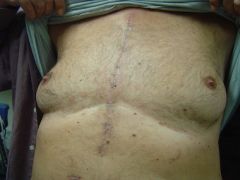
Name the scar and its significance in CV exam |
Midline sternotomy ➙ Open heart surgery, CABG, valve surgery |
|
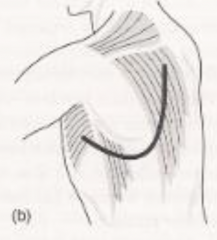
Name of the scar and significance in CV exam |
Posterolateral thoracotomy ➙ Mitral valve surgery |
|
|
Where should they apex beat be palpated? |
5th intercostal space - MCL |
|
|
What are the three signs that can be elicited when palpating the apex beat? What is their significance? |
Forceful/Sustained ➙ Left ventricular hypertrophy Tapping ➙ Mitral stenosis Diffuse ➙ Volume overload |
|
|
Significance of heaves |
Right ventricular hypertrophy |
|
|
Significance of thrills |
Any murmur |
|
|
What do you palpate in a CV exam? |
Apex beat Heaves Thrills |
|
|
What do you auscultate in a CV exam and with what part of the stethoscope? |
1. Aortic area ➙ Diaphragm 2. Pulmonary area ➙ Diaphragm 3. Tricuspid area ➙ Diaphragm 4. Mitral area ➙ Bell 5. Mitral area ➙ Diaphragm 6. Axilla ➙ Diaphragm 7. Carotid ➙ Bell |
|
|
Characterize the murmur you expect to hear in mitral stenosis. |
- Apical region - Mid-diastolic - Non-radiating - Accentuated when pt rolled on the left - Better heard with the bell |
|
|
Characterize the murmur you expect to hear in mitral regurgitation. |
- Apical region - Pansystolic - Radiating to axilla
|
|
|
Characterize the murmur you expect to hear in aortic regurgitation. |
Double murmurs (both in URSE) 1) Mid diastolic 2) Decrescendo systolic murmur
Also hear in the LLSE while sitting forward |
|
|
Characterize the murmur you expect to hear in aortic stenosis. |
- URSE - Systolic - Ejection - Radiates to the carotids |
|
|
Why are reduced breath sounds and crackles relevant for CV examination? |
Suggestive of pulmonary oedema caused by: - Left heart failure - Fluid overload |
|
|
Significance of sacral oedema and pitting oedema in the legs |
Heart failure Fluid overload |
|
|
Name 7 further investigations to do after the common CV examination |
Peripheral vascular exam Lying/Standing BP Pulse oximetry ECG Urine dip CXR Blood tests |
|
|
Observations to be made in the hands in resp exam |
5C's: - Clubbing - Colour (cyan) - Cigarette tar stains - Cancer (wasting of small muscles) - CO2 retention asterixis
Bruises/Purpura |
|
|
Significance of clubbing in resp exam |
Bronchiectasis Pulmonary fibrosis Malignancy |
|
|
Significance of hand muscle wasting in resp exam |
Pancoast tumour |
|
|
Significance of hand bruises/purpura in resp exam |
Steroid therapy as in COPD |
|
|
Significance of lengthening of expiration |
Obstructive airway disease |
|
|
Why is BP important in resp exam? |
Low BP may be indicative of community-acquired pneumonia (part of CURB-65) |
|
|
What are the different elements of Horner's syndrome? |
Miosis Anhidrosis Ptosis |
|
|
Significance of Horner's syndrome |
Pancoast tumour |
|
|
Two causes of facial plethora |
Smoking SVC obstruction |
|
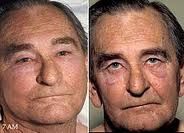
Sign of the picture on the left |
Facial plethora |
|
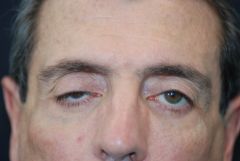
Name of the sign |
Ptosis |
|

Name of the sign |
Miosis |
|
|
Significance of a bright red mouth |
Carbon monoxide poisoning |
|
|
Name four causes of raised JVP in resp exam |
Right ventricular failure Tension pneumothorax Severe acute asthma PE |
|
|
Observations to be made on the face in resp exam (6) |
Conjunctival palor Horner's syndrome Facial plethora Central cyanosis Red tongue Hydration status |
|
|
What do you look for in the neck during resp exam? |
JVP Tracheal deviation Carotid pulse Lymphadenopathy |
|
|
What two scars do you look for during resp exam? What is their significance |
Thoracotomy ➙ pneumonectomy Chest drains in axilla ➙ previous pneumothorax, haemothorax, or pleural effusion |
|
|
What two breathing patterns can we elicit by inspection? What is their significance? |
Sea-saw pattern ➙ Airway obstruction Flail chest ➙ Rib fracture |
|
|
What do you palpate in a resp exam? |
Expansion Apex beat Right ventricular heaves |
|
|
Significance of right ventricular heaves |
Cor pulmonale secondary to pulmonary hypertension |
|
|
What do you percuss in resp exam? |
Upper, middle and lower zone front and back and axillae |
|
|
What do you listen for in resp auscultation? |
Breath sounds (vesicular/bronchial) Crackles Wheezes Rub Vocal resonance |
|
|
Significance of crackles |
Pneumonia Pulmonary oedema Pulmonary fibrosis |
|
|
Significance of wheezes |
Obstruction |
|
|
Significance of rub sound in resp auscultation |
Pneumonia Infarct Pleurisy |
|
|
What do you look for in the legs in resp exam? |
Pitting oedema Unilateral calf swelling/redness/tenderness Erythema nodosum |
|
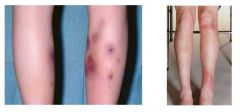
Name of the sign |
Erythema nodosum |
|
|
Significance of unilateral calf swelling/redness/tenderness |
DVT |
|
|
Significance of erythema nodosum |
Inflammation of the fat cells under the skin, as in TB |
|
|
Name 6 common conditions that can be elicited during resp exam |
Consolidation Pleural effusion Lung collapse Pneumothorax Tension pneumothorax Pleural thickening |
|
|
In what conditions may you observe tracheal deviation? In what direction would the deviation be? |
Pleural effusion ➙ Away Collapse ➙ Towards Tension pneumothorax ➙ Away |
|
|
In what resp conditions is the percussion expected to be dull? |
Consolidation Pleural effusion Collapse Pleural thickening |
|
|
In what resp conditions is the percussion expected to be hyperresonant? |
Pneumothorax (simple or tension) |
|
|
In what conditions is vocal resonance increased/decreased? |
Increased only in consolidation Decreased in all other conditions |
|
|
Significance of bronchial breath sounds |
Consolidation |

